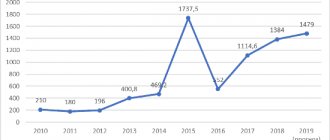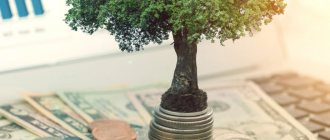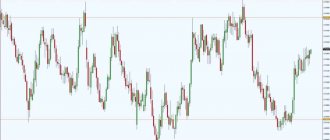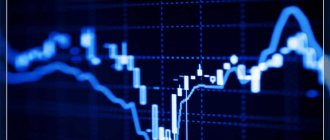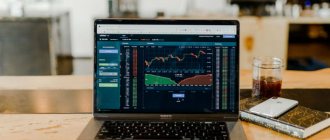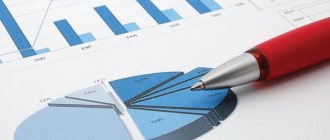You can also calculate the payout ratio using Microsoft Excel:
First, if you are given the sum of a period's dividends and shares outstanding, you can calculate dividends per share (DPS).
Let's say you invested in a company that paid out $5 million last year and has 5 million shares outstanding. In Microsoft Excel, enter "Dividends per share" in cell A1. Then enter "=5000000/5000000" in cell B1; The dividend per share for this company is $1 per share. You then need to calculate earnings per share (EPS) if none are reported. Enter "Earnings Per Share" in cell A2. Let's say the company's net income was $50 million last year. Earnings per share formula: (net income - preferred dividends) ÷ (number of shares outstanding). Enter “= (50000000 – 5000000) / 5000000” in cell B2. The EPS for this company is $9.
Finally, calculate your payout amount. Enter "Payout Ratio" in cell A3. Then enter "=B1/B2" in cell B3; payout ratio – 11.11%. Investors use this ratio to determine whether the dividend is affordable and sustainable. The payout ratio varies by sector; for example, start-up companies may have a low payout ratio because they are more focused on reinvesting their earnings into growing the business.
Dividend Payout Ratio
Dividend Payout Ratio - dividend payout ratio. Shows what share of net profit the company allocates for dividends.
How is the coefficient calculated?
Dividend Payout Ratio = Dividend per share (DPS) / Earnings per share (EPS).
In simple terms. Dividends must be divided by earnings per share.
For example . The company earned 100,000 of some money (profit) in a year. She plans to allocate 70 thousand for dividends. We divide dividends (70 thousand) by profit (100 thousand).
In total we get a coefficient of 0.7. Usually Payout Ratio is taken as a percentage. This means you can multiply the result by 100.
It turns out, from our example, the company allocates 70% of its profits to dividends.
The dividend payout ratio is used to check that a company can maintain its current dividend level in the future.
If a company's Payout Ratio exceeds 100%, this means that the company pays more dividends than it earns in profits. As you understand, this is not a buzz. An alarm bell is that in the future the company will not be able to maintain a similar level of dividends for a long time and will most likely be forced to reduce them.
The second option is that the company needs to increase profits. Thereby reducing the dividend payout ratio. But whether there will be an increase in profits is not known for sure. We can only make predictions.
The best investment strategy is dividend!
Dividend investing is a strategy that gives investors two sources of potential income: predictable income from regular dividend payments and capital appreciation over time due to the appreciation in value of the shares themselves.
Buying dividend stocks can be a great solution for investors seeking income or for those who simply want to grow wealth by reinvesting dividends.
This is a great option for those investors who are looking for a less risky investment, which is often associated with dividend stocks. But there are certain difficulties in the chosen direction, because Some dividend stocks can be risky, especially if you don't have basic stock selection skills.
Why should you invest in dividend stocks?
Investing in dividend stocks is passive income with regular payments. This allows you to create good wealth in the future, taking into account the effect of compound interest.
This method allows you to approach capital formation from two sides.
- Regular dividend payments.
- Capital gains due to the increase in stock value over time.
Let's look at a simple example. You bought 100 shares of Sberbank at 245 rubles. per piece, and he pays 16 rubles. per share per year, which is about 6.5% dividend yield. When investing 100,000 rubles in their shares. per year you would receive 6,500 rubles. in the form of dividend income.
You can do whatever you want with the dividends received - they are already yours by right. You can reinvest them by purchasing more shares of Sberbank, or buy shares of any other company, or you can simply spend them in the store. And this is all regardless of what happens to the shares, i.e. with their value - whether they fell or increased, you don’t care! The main thing is that the business works and brings profit to shareholders.
The beauty of a dividend strategy lies in the predictability of the passive income received, especially if your portfolio is well diversified across economic sectors and industries.
By building a dividend portfolio that targets long-term capital growth, as companies appreciate in value, the total return from dividend stocks can outperform the average return of the rest of the market. But to do this, you need to be confident in the stocks you choose for your portfolio, without getting too carried away by high dividends.
How to choose dividend stocks? Basic indicators
Before you buy any dividend stocks, it's important to know how to value them. The following basic indicators can help you understand how much dividend to expect, how safe a high dividend might be, and whether any dividend stocks should be avoided.
Dividend yield is an indicator presented as a percentage of the share price. For example, if a company pays 10 rubles. annualized dividends, and the share is 200 rubles. per share, the dividend yield will be 5%.
Dividend yields are especially useful when comparing the historical performance of a particular company's stock.
It is important for us to know that the company can maintain the payment of dividends and, preferably, increase them, which is perhaps one of the most important indicators!
Payout ratio - dividends as a percentage of the company's net profit. If a company earns RUB 100 per share in net income and pays dividends of RUB 50 per share, its payout ratio is 50%.
In general, the lower the payout ratio, the more sustainable the dividend should be. For example, Sberbank’s payout ratio is planned to be 50% of net profit in 2021, and the projected dividend yield is 7.9%.
Cash payout ratio - The cash dividend payout ratio can be a useful metric to use alongside the earnings payout ratio since earnings can vary significantly from cash flows, especially from one quarter to the next.
Total return (total income) – the total return of shares. The total income received from dividends and profits from stock appreciation during the year. For example, if a stock grows 10% this year and pays a dividend yield of 5%, its total return will be 15%.
EPS (earnings per share) . The point is that the company can earn more than it pays dividends on the shares themselves.
After all, where else would it get money to pay dividends to shareholders? And the more efficiently a company operates, the more often and regularly they increase earnings per share.
Companies that demonstrate strong earnings per share growth are competitive among others and coveted by investors.
P/E (price to earnings ratio) is the ratio of price to earnings per share. It is simply calculated as P/E = share price/EPS . Example: share price 244/earnings per share 40.42 = 6.03.
This is a small indicator, and it is different for each country. For the Russian Federation, a company with an indicator of 8-10 is considered undervalued; in the USA, an indicator of up to 30 is considered normal, if the company is overvalued by the market above.
These indicators can always be found on the company’s official websites in the investor reports section.
Key indicators for Sberbank shares.
High dividends are not a panacea
Beginner investors always make the same mistake of looking for companies with the highest dividends. Of course, there's nothing wrong with a good dividend, but in most cases, a high dividend signals that a company may be in trouble.
Some tips on how not to buy such stocks:
- Be sure to use the Payout ratio to see the sustainability of dividend payments.
- Look at the history of dividend payments, the higher it is, the better.
- Evaluate the company by its P/E ratio (price to earnings ratio) and compare it with competitors in the same industry.
McDonalds dividend history.
Best Dividend Strategy
If you are a long-term investor who wants to have a large amount of capital over time, it is best to reinvest dividends.
This is a case of money making itself, and the easiest way to use the power of time and the complex work of interest to your advantage.
Don't forget to also read interesting articles about Dividend Aristocrats in Russia or the USA, which present stocks that are best suited for a dividend strategy!
Source: https://invest-journal.ru/luchshaja-strategija-investirovanija
The dangers of high dividends
The company may fall into the so-called dividend trap. This is especially noticeable among dividend aristocrats (who pay and constantly increase their dividends every year).
What happens over the years with consistent dividend increases? If this growth is higher than profit growth. That's right...Payout Ratio increases. At first, 30-40% of profits go to dividends. After a few years it reaches 70-80%. Then it creeps up to 90-100%. And higher. 120-150% and even 200-300%.
Naturally, another company can still pay divas in full from its financial reserves for a year. So what is next?
We have to reduce the dividend payout ratio to an acceptable level.
For investors, this means a decrease in cash flow. Sometimes very significant. Literally exponentially.
They paid you a thousand a year, you will receive 200 bucks. Not very nice.
Share dividend yield ratio
To assess the profitability of shares, several types of dividend yield ratios are used:
- Nominal;
- Current;
- Total;
- Full.
The first two coefficients are the easiest to calculate:
- Nominal = annual dividend per 1 share / Nominal share price,
- Current = annual dividend per share/Current (market) share price.
The two indicators described above can be compared with similar indicators of other enterprises, as well as with each other. For calculations, investors use exactly the current value of shares, since the nominal value is rather arbitrary and does not reflect the real market picture.
When selling, the total return on shares is calculated - the ratio of total income to invested funds. Total income is the sum of dividend income and foreign exchange income (exchange income).
Exchange rate income is calculated as the difference between the cost of selling and buying shares. Invested funds are the money spent on purchasing a given stock.
Formula for calculating the total stock return ratio:
- Ktotal = (Dividends + (sale price - share purchase price)) / Share purchase price.
- The most complete picture is provided by the total return on shares:
where d is the amount of dividends in a certain year, Pt is the market price of the share in the t-th year (i=1,2,3...), Po is the purchase price of the share, T is the number of years of holding the shares.
Calculation example
For example, shares were purchased for 130 rubles per share on September 1, 2015, and on May 30, 2021, sold for 160 rubles per share. During this time, dividends in the amount of 12 rubles were received.
The table is an example of calculating the profitability of a stock.
| Index | Meaning | Coef. total return on shares (dividends + exchange rate differences) | Coef. current stock return* |
| Share purchase price, rubles | 130 | 32% | 8% |
| Sale price of shares, rubles | 160 | ||
| Dividends received | 12 |
* the sale price of the stock was used as the current price in the calculation
Examples from history
A striking example is General Electric. With a very rich dividend history (more than 100 years of dividend payments).
When the payout ratio exceeded 100%, the company was unable to maintain this level for long. And in 2010, it reduced dividends by 3 times (from 0.31 to $0.1).
The second jump down occurred in 2021. From 24 cents, the divas fell to 12. And in 2021, the company generally paid symbolic dividends of 1 cent per share.
Over 8 years, GE reduced dividends by 31 times!
Of course, there were also other unfavorable factors, primarily a strong decline in net profit. And just based on the Payout Ratio indicator, this could have been foreseen in advance and some measures could have been taken.
General Electric dividends
By the way, now, with the current dividend yield of GE, the Payout Ratio is negative. This means that the company has no profit at all.
Let's take another example. APPLE company. It does not yet have a very rich dividend history. The first divas began to be paid only in 2013.
The current Dividend Payout Ratio is 26%. That is, the company allocates only a quarter of its profits to pay dividends to its shareholders. Increasing them by an average of 11% annually. And with a greater degree of probability we can assume that it will maintain stability in this regard for many years. And the risks of reducing dividends in the future are minimal.
APPLE dividends
What are dividends and how are they calculated?
A dividend is a certain share of the profit of a large business entity, and shareholders receive it in certain proportions. In my material about apple shares, I said that you can count on payment of profits that were not paid for a long time, but invested in development) or wait for a better price and then sell.
By purchasing securities on the stock exchange, you can find out information about the company and the nearest dividend payment date.
Since dividend income is the total profit from all companies where you are a shareholder, you can form capital depending on the frequency of payment of profits from companies.
Optimal Payout Ratio Size
In the classic version, the optimal coefficient size should not exceed 70%. The company has a margin of safety for future payments + dividend increases. Without compromising financial stability.
Anything above carries certain risks both for the company itself and for the investor.
But here, too, you need to take a sensible approach to assessing the coefficient.
For example, if we look at real estate funds (Reits), which attract investors with their high dividend yields, they typically allocate more than 90% of their profits to dividends. But in return they receive tax benefits from the state.
Or let's take for example the largest value companies (Coca-Cola, Pepsi, McDonald's, Johnson & Johnson). They have already captured their market share. Have a stable cash flow. There is practically nowhere for them to develop further. What to do with the profit? Salt?
For such companies, the dividend payout ratio may be higher. Let's say up to 80-85%. And they can quite easily continue to pay and increase the divas every year. But it must be a very stable company that has a competitive advantage over its peers.
Where can I look at the dividend payout ratio?
On the website Finfiz.com.
In the Screener tab. Click the “All” button. We are looking for the “Payout Ratio” field. We set the required coefficient (more or less than a certain percentage).
For example, companies with a capitalization of more than $200 billion, which currently have a dividend payout rate of more than 90%.
Received by 2 companies: Coca-Cola and Procter & Gamble. There is already reason to think about investing in these companies.
The disadvantage of Finviz is that there is no information on Russian companies. Focus only on stocks traded on US exchanges.
Let's go to investing com. You can also search for Russian companies. We need a stock filter (link). Let's repeat similar settings. And we get almost the same result.
If you get into the company, you can look at the information on the size of dividend payments. Tab “Reporting -> Ratios”. Let's go to the very bottom. We are looking for “Dividend payout ratio”. As you can see for PG it is critical - almost 200%.
For Russian companies, more visual information is presented on Smartlab (link).
